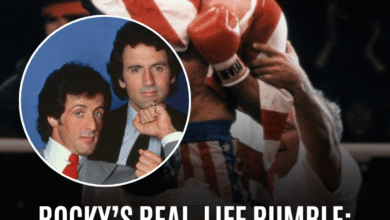Marilyn Monroe’s ‘Diamonds’ Dress Almost Didn’t Happen—Thanks to A Photo Scandal That Rocked Hollywood
OPINION: This article may contain commentary which reflects the author's opinion.
Marilyn Monroe’s pink dress from the 1953 film Gentlemen Prefer Blondes has become one of the most iconic fashion moments in cinematic history, particularly due to its role in the unforgettable “Diamonds Are a Girl’s Best Friend” musical number. However, what many don’t know is that this dazzling pink gown almost didn’t exist at all. The creation of the dress was nearly derailed by a photo scandal involving Monroe’s nude calendar shots, a controversy that forced a last-minute redesign to protect her image. The pink dress, which would go on to define Monroe’s legacy in Hollywood and fashion, was born out of this very crisis.
The Film Production and Original Design
Gentlemen Prefer Blondes, directed by Howard Hawks, starred Monroe as the gold-digging Lorelei Lee alongside Jane Russell. The costumes for Monroe’s character were designed by the legendary William Travilla, who had already made a name for himself with his work on other Monroe films, including Monkey Business (1952). Travilla, who famously claimed that his clothes for Monroe were “an act of love,” had a deep admiration for the actress, which was reflected in his designs. However, what was supposed to be a glamorous, eye-catching costume for Monroe’s star turn in Diamonds Are a Girl’s Best Friend nearly became a casualty of scandal.
The Nude Calendar Controversy
The controversy that almost derailed Monroe’s iconic look centered around a set of nude photographs taken by photographer Tom Kelley in 1949, when Monroe was struggling financially. These images, which were originally snapped for a modest sum of $50 to help Monroe pay her rent, found their way into a calendar and were later featured in the debut issue of Playboy in December 1953, right as Gentlemen Prefer Blondes was in production.
The release of these photos created a public uproar, especially given the conservative cultural atmosphere of the time. Journalist Aline Mosby uncovered the story in 1952, bringing the scandalous photos into the public eye during the production of Gentlemen Prefer Blondes. Monroe, ever the master of managing her public image, explained in an interview that the photos were a necessity, as she had “nothing else to wear.” Her candid admission to the situation helped soften the scandal, but at the time, the studio was concerned about the impact on her image and the film’s reception.
The Original Costume Design and the Push for a Change
Travilla had initially designed a stunning nude bodystocking for the Diamonds Are a Girl’s Best Friend number. The costume featured fishnet hose and jewels sewn onto the material, and it was estimated to cost around $4,000 in 1953 dollars—an extravagant sum for a single piece of wardrobe. However, in light of the nude photo scandal, studio head Darryl F. Zanuck was concerned about the potential backlash and decided that the outfit was “too sexy” for Monroe’s current public image. He ordered a redesign to mitigate any further association with the scandal.
This directive from Zanuck almost meant that the original costume would be scrapped entirely, and the iconic pink dress was hastily conceived as a replacement. Travilla, with little time to spare, created the pink gown in just two days, working quickly to produce an alternative that would keep Monroe’s image intact while still being glamorous enough for her performance.
The Creation of the Pink Dress
Travilla’s redesign for Monroe was a sweeping success. He crafted the dress out of candy-pink peau d’ange silk, which was backed with green billiard felt for structure. The design featured only two side seams, giving it a streamlined, elegant silhouette. The dress was adorned with rhinestone details, which shimmered beautifully in the spotlight during the musical number. This new gown was less revealing than the original bodystocking, aligning more closely with the studio’s desire to protect Monroe from any further controversy.
The pink dress was an instant hit, and its impact extended far beyond the film. It became a symbol of Monroe’s sensuality and glamour, helping to solidify her place as one of Hollywood’s most iconic stars. The dress not only dazzled on screen but also sparked a broader cultural impact, influencing fashion and inspiring countless imitations.
The Impact on Monroe’s Career and Legacy
Despite the initial damage caused by the nude photo scandal, the controversy ultimately worked in Monroe’s favor. Her candid handling of the situation, coupled with her vulnerability and self-awareness, helped turn the narrative around. By openly admitting to the photos, Monroe garnered sympathy and increased her fame. This led to a boost in public interest, and her already substantial career continued to flourish.
The pink dress, which was born out of a need to protect Monroe’s image, became one of her most enduring fashion moments. It has since been referenced in pop culture, most famously in Madonna’s Material Girl music video, and is regularly celebrated in fashion retrospectives. The dress represents not only Monroe’s beauty and star power but also the way in which Hollywood sought to navigate and sometimes control the personal lives of its stars.
A Lasting Icon
The story of Marilyn Monroe’s pink dress from Gentlemen Prefer Blondes is a fascinating tale of fashion, scandal, and the complexities of celebrity culture in 1950s Hollywood. It’s a reminder that even the most iconic looks in cinematic history were sometimes shaped by the forces of public perception and media scrutiny. In the end, the dress became a masterpiece that transcended its origins, cementing Monroe’s place as a fashion and cultural icon.
Through this controversy, the pink dress not only secured its place in fashion history but also highlighted the resilience of Monroe, who continued to shine despite the challenges and controversies that often surrounded her life. The creation of the pink dress remains a powerful symbol of how fashion, film, and public relations intersected to shape one of the most iconic moments in Hollywood history.



